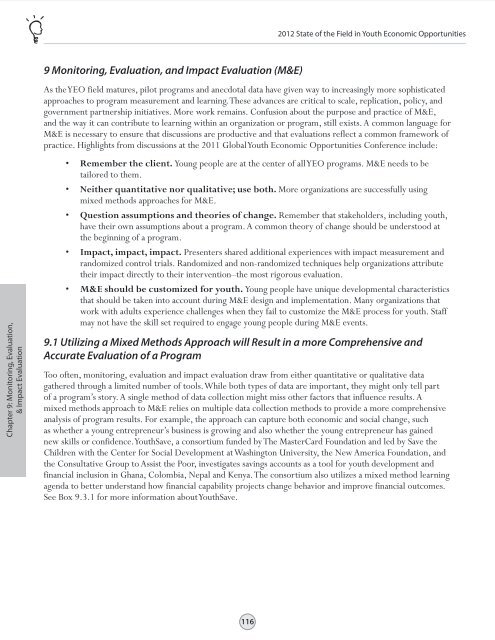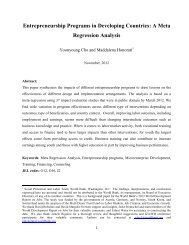STATE OF THE FIELD IN YOUTH ECONOMIC OPPORTUNITIES
STATE OF THE FIELD IN YOUTH ECONOMIC OPPORTUNITIES
STATE OF THE FIELD IN YOUTH ECONOMIC OPPORTUNITIES
You also want an ePaper? Increase the reach of your titles
YUMPU automatically turns print PDFs into web optimized ePapers that Google loves.
Table of Contents<br />
Chapter 9<br />
Chapter 1 Chapter 2 Chapter 3 Chapter 4 Chapter 5 Chapter 6 Chapter 7 Chapter 8<br />
Chapter 10 Chapter 11 Chapter 12 Chapter 13 Chapter 14 Chapter 15 Annexes<br />
2012 State of the Field in Youth Economic Opportunities<br />
9 Monitoring, Evaluation, and Impact Evaluation (M&E)<br />
As the YEO field matures, pilot programs and anecdotal data have given way to increasingly more sophisticated<br />
approaches to program measurement and learning. These advances are critical to scale, replication, policy, and<br />
government partnership initiatives. More work remains. Confusion about the purpose and practice of M&E,<br />
and the way it can contribute to learning within an organization or program, still exists. A common language for<br />
M&E is necessary to ensure that discussions are productive and that evaluations reflect a common framework of<br />
practice. Highlights from discussions at the 2011 Global Youth Economic Opportunities Conference include:<br />
Chapter 9: Monitoring, Evaluation,<br />
& Impact Evaluation<br />
• Remember the client. Young people are at the center of all YEO programs. M&E needs to be<br />
tailored to them.<br />
• Neither quantitative nor qualitative; use both. More organizations are successfully using<br />
mixed methods approaches for M&E.<br />
• Question assumptions and theories of change. Remember that stakeholders, including youth,<br />
have their own assumptions about a program. A common theory of change should be understood at<br />
the beginning of a program.<br />
• Impact, impact, impact. Presenters shared additional experiences with impact measurement and<br />
randomized control trials. Randomized and non-randomized techniques help organizations attribute<br />
their impact directly to their intervention–the most rigorous evaluation.<br />
• M&E should be customized for youth. Young people have unique developmental characteristics<br />
that should be taken into account during M&E design and implementation. Many organizations that<br />
work with adults experience challenges when they fail to customize the M&E process for youth. Staff<br />
may not have the skill set required to engage young people during M&E events.<br />
9.1 Utilizing a Mixed Methods Approach will Result in a more Comprehensive and<br />
Accurate Evaluation of a Program<br />
Too often, monitoring, evaluation and impact evaluation draw from either quantitative or qualitative data<br />
gathered through a limited number of tools. While both types of data are important, they might only tell part<br />
of a program’s story. A single method of data collection might miss other factors that influence results. A<br />
mixed methods approach to M&E relies on multiple data collection methods to provide a more comprehensive<br />
analysis of program results. For example, the approach can capture both economic and social change, such<br />
as whether a young entrepreneur’s business is growing and also whether the young entrepreneur has gained<br />
new skills or confidence. YouthSave, a consortium funded by The MasterCard Foundation and led by Save the<br />
Children with the Center for Social Development at Washington University, the New America Foundation, and<br />
the Consultative Group to Assist the Poor, investigates savings accounts as a tool for youth development and<br />
financial inclusion in Ghana, Colombia, Nepal and Kenya. The consortium also utilizes a mixed method learning<br />
agenda to better understand how financial capability projects change behavior and improve financial outcomes.<br />
See Box 9.3.1 for more information about YouthSave.<br />
116

















